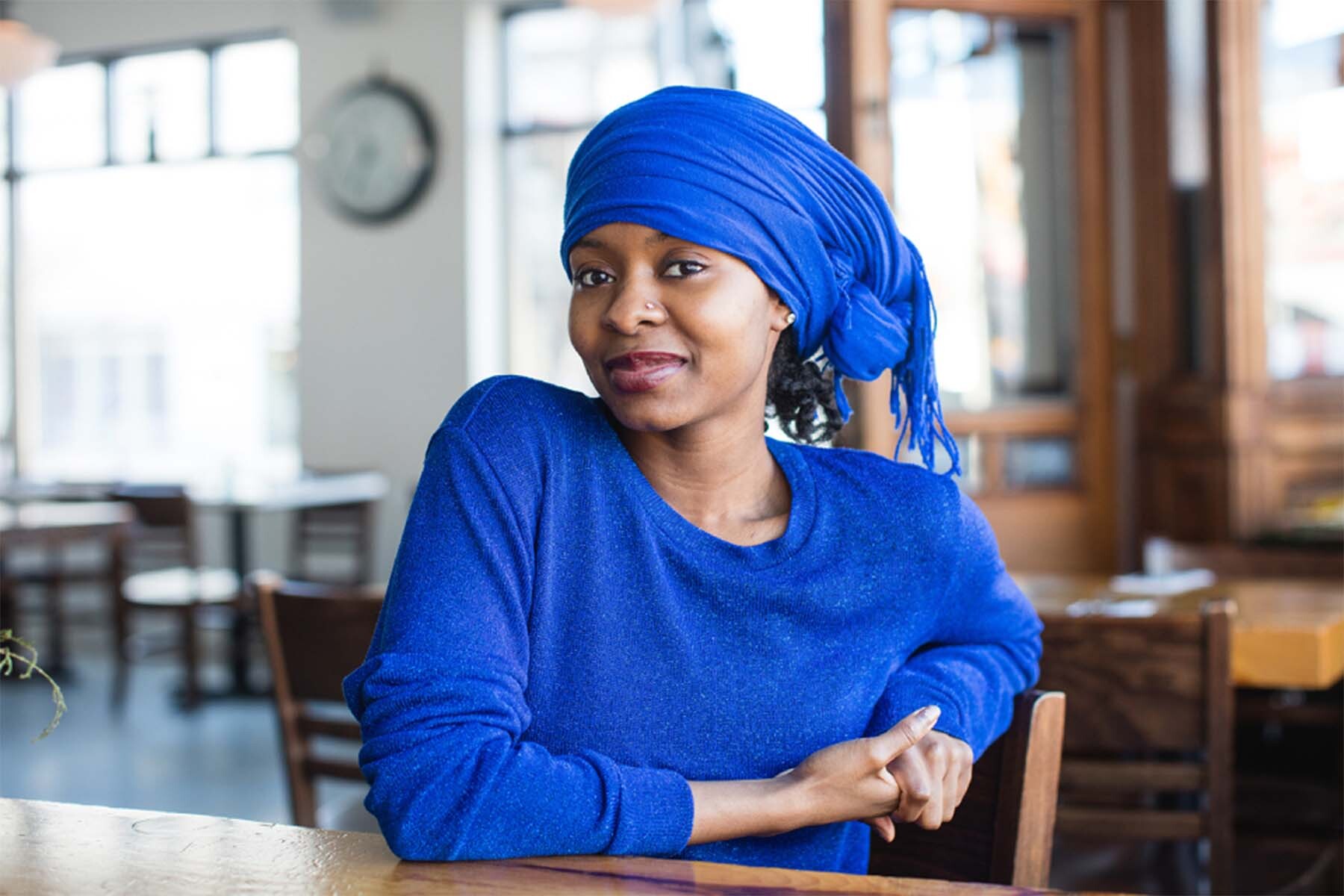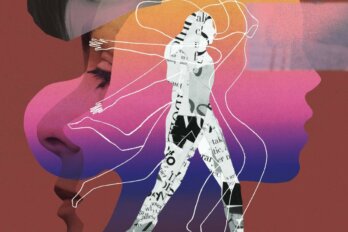Listen to an audio version of this story
For more audio from The Walrus, subscribe to AMI-audio podcasts on iTunes.
The following excerpts are from the published high school diary of Habiba Cooper Diallo as she navigated grades eleven and twelve. They have been edited for length and clarity.
November 15, 2012
High school hurts the Black body. High school is hard enough on any young body. All students grapple with stress, lack of sleep, lugging heavy textbooks through icy Canadian winters and up and down stairs, and regular teen angst, but there is a whole other layer of constant and in some ways unseen violence that is done to young Black bodies in high school that needs to be recognized, because Black students must also deal with the racial stresses involved in going to school.
During the lunch hour, a student quite often remarks (and I’ve heard it so many times that it is sickening), “Don’t waste your food because there are starving children in Africa who would be grateful for it” or “There are places in the world—like Africa—where children cannot go to school, so be thankful that you’re getting an education.” Africa has become a kind of punctuation in our sentences, inserted wherever conscience and empathy are needed. But is the impetus for these catchphrases really empathy when students who identify as African contradict the notions of a needy, impoverished Africa?
Eventually, these statements take on the form of epistemic violence, rendering the acquisition of knowledge difficult for the Black student. How is one to concentrate on a chemistry lesson or a biology assignment after being told that Africans like her cannot go to school?
High school stigmatizes the Black body. At my school, I recently witnessed the arrest of a Black student. Prior to the incident, two officers were interrogating him and his non-Black friend on school property. The latter was escorted back inside the school while the former was kept outside for further interrogation. I continued to watch through the window. The officer soon began to search him, clearly unable to find anything worthy of arrest. She persisted nonetheless and, in doing so, provoked him. He became frantic, kicking off his shoes and waving his arms as he proclaimed his innocence. The officer was unrelenting. Within seconds, his chest was pressed against the side of a car, his back to me and his hands cuffed. Adding insult to injury, a student next to me, having also witnessed the arrest, remarked, “He knows the drill.”
I could feel my heart sink, and soon the tears began to flow—a physical manifestation of the impact of high school on the Black body—as he was driven away, coerced away, from an education, from the school that, we are told, is the most essential component of a student’s future success. We are told that school is a “safe” and “healthy” place. Given all that, how can it coexist with legal, police-authorized coercion away from learning?
High school hinders the Black body. The bell rang exactly nine minutes after the arrest. Shattered and demoralized as I was, I still had to report to my fourth-period biology class. I had to fulfill my academic responsibility.
High school nullifies the Black body. In spite of the major contributions Black people have made and continue to make to Canadian society, and in spite of our sheer presence across the country, in school, there is an erasure of the histories and contemporary experiences of Black people in Canada. During Remembrance Day ceremonies, why don’t we remember the Black veterans of the First World War from Nova Scotia’s No. 2 Construction Battalion? I often look through my textbooks and count the bodies depicted as inventors, prominent political figures, and theoreticians relative to those depicted as victims of war, inadequate health care, famine, and political instability. The former are usually white people, the latter people of colour—typically Black people.
How does the erasure of the Black experience and the suppression of Black students nullify the Black body? The first strike is psychological—Black students’ consciousness of the lack of recognition of the Black experience. This is followed by an emotional response—dejection and apathy toward school as there is no relevance to the experience for Black students. Finally, the Black student goes into a state of corporeal shock, questioning the significance of her skin, her features, her hair, and fundamentally her body in a system that suppresses the expression of her humanity.
November 22, 2013
Tonight was my school’s multicultural show. There were several acts—dancehall, hiplife, Persian dance, etc. Our school is the most diverse school east of Montreal. During one of our dancehall rehearsals, a white girl who was considering participating in our dance entered the drama room (our practising space) and said, “Oh, it’s so sexual.”
“Um, no, it’s not,” I shot back. “For us, it’s a dance.”
“Yeah, it’s not sexual. This is the culture,” our choreographer chimed in.
Why doesn’t she just leave? I wondered. She eventually did. Following the performance: “Ooh, mama, I saw you getting down and dirty,” one boy told my co-dancer, referring to a hiplife dance I’d choreographed. I scowled at him. Down and dirty? I thought. You mean I put in all these hours to choreograph, teach, and embellish our routine only to be told we were getting down and dirty?
Nonetheless, there was enough positive feedback to offset the “down and dirty.” One of my friends rushed me at school the next day, exclaiming, “My mom loved your dance! She kept saying, ‘Oh my God, they’re so good!’” A teacher ran into me in the hallway and said, “You’re the dancer, aren’t you? You were glorious on stage, just glorious.”
March 25, 2014
There is a graphic whitewashing of school through posters. In classes, images of Albert Einstein and scenes from Hamlet, Pride and Prejudice, etc. are plastered to walls. Every so often, you catch a glimpse of the token Black person “messiah-ed”—as my friend would say—through the Black History Month posters produced each year.
I am not necessarily opposed to these posters. They do highlight the important contributions of Black Canadians to Canadian society—something that is often ignored by mainstream media and literature. My mother is actually featured on one of the posters, which is in my school’s library, for her groundbreaking work on slavery in Canada. The problem is that, when the treatment of the Black posters is contrasted against the treatment of the white posters, it becomes obvious that Blackness in Canada is “messiah-ed” at best, stigmatized and nullified at worst, but never just normal.
The posters do bring Blackness to the attention of students and staff in a celebratory way. Every Black History Month, you can count on a poster highlighting Black achievement accompanied by a traditional African dance put on by the students or an assembly featuring a prominent Black figure who tells students, “I did it in spite of racism and so can you!” While all this is great, it does not critically engage with the day-to-day reality of Black students in an educational system that nullifies our experiences.
For example, I am aware—and have been since elementary school—that Rosa Parks was the catalyst for the Montgomery bus boycott, that Martin Luther King Jr. gave the foundational “I have a dream” speech. Thanks to antiracist activists like Parks and King, Black people have made social gains such as securing access to education. Now, how can we use their legacies to challenge the racist, anti-Black realities that alienate Black students in high school?
In addition to the African dance performance, we could have a course or a section in the history curriculum that includes an analysis of the nuances of African dance forms—sabar, eskista, coupé-decalé, soukous, ndombolo, mandiani, kwela—and talks by experts about the ways in which many of these genres were used as a form of resistance against imperialist rule (as in the case of South African kwela).
Still, the Black History Month posters are fantastic. Nonetheless, time and time again, their relevance has been questioned.
And, most importantly, inclusion for Black people is not reflected in a critical academic fashion or in the overall context of school culture. I define school culture as the overarching spirit of the school, which is expressed through important ceremonies and events such as Remembrance Day and spirit rallies. But I also define it as the attitudes and politics of staff and students that pervade learning and existence within the school. Certain attitudes and politics take precedence. The ones that do inevitably shape the extent to which a student feels that she belongs in the school. In my high school experience as a Black student, my ideologies about school culture have not been particularly endorsed.
I would rather my identity as a Black student not be tokenized through “Multicultural Week.” Like, really? Only a week for multiculturalism? I am “multicultural” (as some like to put it) all year. I do not start being multicultural at the beginning of a week in November and stop at the end of that week and reassimilate into Eurocentric school culture.
April 1, 2014
I just left history class. On my way up to my English literature class on the second floor, I pressed the button for the elevator when a young teacher in a bright-pink sweater stormed my way. “Excuse me, you can’t use the elevator!” she said, raging. “No. I have a pass,” I said. She didn’t even listen.
“No! I don’t care. C’mon!” she said, snapping her fingers at me. “Take the stairs!” Finally, she got a hold of her barking self and asked, “Do you have a card?”
Had she listened to me a sentence ago, she wouldn’t have made herself look like such an imbecile. “Yes, I do,” I said.
“Let’s see,” she said roughly.
I presented my pass.
“Who gave it to you?” she asked, peering at my pass suspiciously.
I should have told her that I’d smuggled it from the office. She turned around and briskly walked away when she saw that my vice principal had signed my elevator pass. What a bitch, I thought. I got on the elevator and chuckled to myself. She clearly is not happy with herself. The woman had snapped at me and pointed in the direction of the stairwell. “C’mon!” she had said, as if I were a dog. I am mad. I will be going to my vice principal right after this class to express my discontent. I guess it is unfortunate that something as trivial as an elevator pass can drive someone into a two-minute conniption. I consider it an indication of our skewed priorities as a society. Sigh.
June 2, 2014
“But why should I wear the kente sash?” I asked my mom. “For the whole school year, there is no recognition of ‘African-ness,’ and then suddenly at graduation when African or Black students are leaving, we are encouraged to wear the kente sash?”
Tomorrow, I will be having my graduation for successfully completing the International Baccalaureate Diploma Programme. Later in June, there will be another graduation at which I will receive my provincial high school diploma. Starting around January / February, the daily morning announcements included, “If you are African Nova Scotian and would like to wear the kente sash at graduation, please come to the main office and let one of the secretaries know.”
I chuckled every time I heard that announcement. It just sounded so awkward. Firstly, what on earth is a “kente sash” for those who do not know? And what does being African Nova Scotian have to do with wearing the kente sash? I guess my frustration with the invitation to wear the sash is that, while it does symbolize African culture, in the context of the nullification of African and Black culture in school, it appears to be a surface-level remembrance.
The Department of Education and Early Childhood Development has an academic scholarship for African Canadian students. A few months ago—during one of my regular scavenger hunts in the guidance office—I found one of the applications sitting in a dusty pile at the bottom of a bookcase. I quickly informed my African Canadian and Black peers, distributing copies to a few of them. You will automatically get the scholarship if you have an average over 75 percent. A win indeed. So what’s more important: advertising the sash for months leading up to graduation or advertising the scholarship?
June 27, 2014
Today was the graduation! It was big, let me tell you: a graduating class of 436 students. The International Baccalaureate graduation was smaller. It was an intimate celebration. But today’s ceremony was for all graduating students regardless of their academic programs.
It was interesting. I am extremely happy to be done this journey. It was too long, as far as I’m concerned, and too carelessly hurtful. I think I would have been good with two years only.
My friend gave the valedictory address along with another student. Her co-valedictorian talked about what it means to be a “warrior”—our school icon. Many of her definitions of what it means to be a warrior did not resonate with me. In her concluding definition, she declared her pride in being from a diverse school.
Hmm, I thought, I guess, for some, having diversity on the surface level—the student body—is enough. And, for them, that’s okay. But, for others, like myself, it is simply not enough. I am part of that surface-level diversity as a Black student, but I am not proud of it because, at a deeper level, the lack of diversity has been so discouraging.
Following the ceremony, I returned to school with my friend for the reception. My beloved French teacher joined us there. “I hope you find happiness wherever you go, because you deserve to be happy,” she told me. “I loved how you’d enter the classroom dancing and singing on some mornings. If only you knew what it did for me. You have a happy bird inside you.” How sweet. She uttered those words at such a timely moment, because today I needed them most. I was having a particularly difficult graduation.
My friend and I ended the reception by saluting some teachers and fellow graduates and signing their yearbooks. My last few moments spent at the school were heartfelt. It seems that, throughout the school year, so many of my moments were heartfelt but with so much negativity surrounding them. Closure is good indeed. It opens up the way for a new beginning, one that is potentially better than what came before. Of course, that statement is very vague.
Afterward, I went and grabbed a bite to eat, then I went for a long walk with a few stops and phone calls in between. “Hold on to your core values even when people don’t like it,” my friend told me. “At least you know you’ve stayed true to yourself.” Another friend, two nights prior: “Overcoming one test is merely a preparation for a bigger one. The first one is meant to strengthen you for the second. . . . Every step you take today is a graduation from yesterday. It’s the journey to the graduation that matters.”
Excerpted from #BlackInSchool by Habiba Cooper Diallo. © Habiba Cooper Diallo. Adapted with permission of the publisher, the University of Regina Press. All rights reserved.




